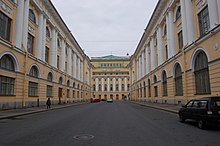Vaganova Academy of Russian Ballet
| Vaganova Academy of Russian Ballet | |
|---|---|

Long shot of the academy, from across the Architect Rossi Street
|
|
| Location | |
|
Saint Petersburg Russia |
|
| Coordinates | 59°55′49″N 30°20′09″E / 59.9303°N 30.3358°ECoordinates: 59°55′49″N 30°20′09″E / 59.9303°N 30.3358°E |
| Information | |
| Type | Ballet school |
| Established | May 4, 1738 |
| Campus type | Urban |
| Website | http://vaganovaacademy.com |
The Vaganova Academy of Russian Ballet is a school of classical ballet in Saint Petersburg, Russia. Established in 1738 during the reign of Empress Anna, the academy was known as the Imperial Ballet School up until Soviet times, when, after a brief hiatus, the school was re-established as the Leningrad State Choreographic Institute. In 1957, the school was renamed in honor of the renowned pedagogue Agrippina Vaganova, who cultivated the method of classical ballet training that has been taught there since the late 1920s. Graduates of the school include some of the most famous ballet dancers, choreographers and teachers in history and many of the world's leading ballet schools have adopted elements of the Vaganova method into their own training.
The Vaganova Academy is the associate school of the Mariinsky Ballet, one of the world's leading ballet companies. Students of the school have found employment with ballet and contemporary companies worldwide, such as the Bolshoi Ballet, The Royal Ballet, American Ballet Theatre and the Mikhailovsky Ballet.
The school was established as the Imperial Theatrical School by decree of the Empress Anna on 4 May 1738 with the French Ballet Master Jean-Baptiste Lande as its director. The first classes occupied empty rooms in the Winter Palace in St. Petersburg and the first students were twelve boys and twelve girls. The purpose of the school was to form Russia's first professional dance company, which led to the formation of the Imperial Russian Ballet, the school becoming known as the Imperial Ballet School. The Imperial Russian Ballet is the direct predecessor of today's Mariinsky Ballet.
Nearly all the early teachers at the school were from Western Europe, including Franz Hilferding and Giovanni Canzianni. The first Russian teacher to join the school was Ivan Valberg. After the spread of ballet in Europe, the development of the school was influenced by a number of other teachers and methods, including Christian Johannson, a student of August Bournonville, and the Italian methods of Enrico Cecchetti, Pierina Legnani and Carlotta Brianza. Other renowned 19th-century dancers and ballet masters who taught at and were influential in the development in the school include Charles Didelot, Jules Perrot, Arthur Saint-Léon, Lev Ivanov, Marius Petipa and Mikhail Fokine.
...
Wikipedia
